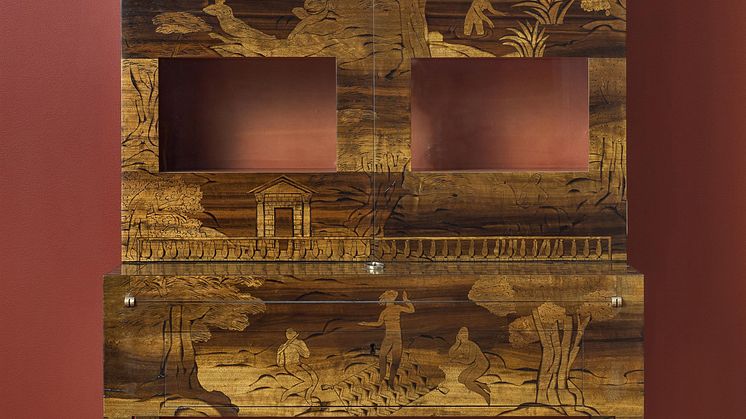
Press release -
New acquisition: Uno Åhrén’s unique cabinet from 1924
In conjunction with the reopening of Nationalmuseum, the association Nationalmusei Vänner has donated Uno Åhrén’s unique cabinet called The Garden of Eden, also known as The Paradise Cabinet. It was displayed in a ladies’ drawing room, or a boudoir, at the 1925 Paris Exhibition, that was furnished by the architect Uno Åhrén. This cabinet is the only one that was made, which makes it not only a rarity of great international interest, but also an exquisite piece of designer furniture that sums up the Swedish Grace style of the 1920s.
For close to a century, Uno Åhrén’s (1897-1977) interior design of a ladies’ drawing room at the Paris Exhibition in 1925 was reduced to a well-known black-and-white photograph in the standard design history reference works. The furniture ended up in the hands of private collectors, but, fortunately, some of these pieces have in come on to the market in recent years. In 2011, Nationalmuseum acquired an armchair and table from Åhrén’s ladies’ drawing room with the aid of funds from the Barbro Osher Pro Suecia Foundation. The museum has now been given the exclusive cabinet that was part of the furnishings as a donation from Nationalmusei Vänner.
The cabinet is made with inlaid wood, which means that patterns have been created using different types of wood in thin veneer. The motif is paradise, where Adam and Eve are living among exotic plants and animals. The untrustworthy snake wriggles on the lid of the writing board, tempting them to eat the apple that grows in the Tree of Knowledge. The material is lavish. The inlaid wood on the sides and doors of the cabinet is made of Brazilian walnut, eucalyptus and tropical olive wood, while the writing board is made of African ebony. The cabinet doors feature glass of different geometrical shapes, and the light-red leather the cabinet is decorated with is visible inside of these. At the 1925 Paris Exhibition, the shelves held objects such as engraved glass from Orrefors. The handle, key and fittings are made of silver-plated metal.
Uno Åhrén was a city planner, architect and interior designer in the first half of the 20th century. After the 1925 Paris Exhibition he became one of the leading advocates of functionalism, among other things he was one of the members of the group that organised the 1930 Stockholm Exhibition. Åhrén’s participation in the Paris Exhibition became problematic for him. On one hand, the exclusive Swedish design with a high level of craftsmanship and artistic decorative quality gained great international acknowledgement. On the other hand, Åhrén experienced a professional crisis that lead to the exposition becoming a turning point for him. It was a visit to Le Corbusier’s Pavillion L’Ésprit Nouveau that made him re-evaluate his artistic work. Le Corbusier presented a modernist home in simple, austere shapes with monochrome, undecorated surfaces that would facilitate mass production.
His contact with Le Corbusier’s pavilion lead to Åhrén writing a very self-critical article called “Brytningar” (Divergences), in the 1925 annual book of Svenska Slöjdföreningen (Swedish Handicraft Association). However, he did not only distance himself from his own participation in the Paris Exposition, he also actively argued in favour of the modern design of functionalism. It was to be created by anonymous designers who were to be at the service of society without ever emphasising their own individual artistic ability. It is likely that Åhrén’s self-criticism became a contributing factor to his own interior design in the 1925 Paris Exhibition being treated as a parenthesis – a “youthful misstep” – in his career when the history of 20th century design was written. However, this does not prevent us from appreciating his exclusive interior design with furniture of exquisite quality today. Nationalmuseum has no budget of its own for new acquisitions, but relies on gifting and financial support from private funds and foundations to enhance its collections of fine art, design and applied art.
More information
Cilla Robach, senior curator applied art and design, cilla.robach@nationalmuseum.se, +46 (0)8 5195 4305
Hanna Tottmar, press officer, press@nationalmuseum.se, +46 (0)8 5195 4400
Categories
Nationalmuseum is Sweden’s museum of art and design. The collections comprise older paintings, sculpture, drawings and graphic art, and applied art and design up to the present day. The museum building has currently been renovated and reopened October 13, 2018. Nationalmuseum has partnerships with Svenska Dagbladet and the Grand Hôtel Stockholm.

